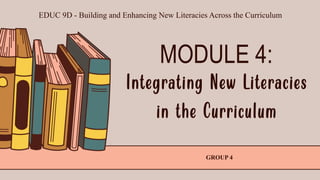
EDUC-9-PPT-G4 report hehehehheehhehhwhwhwhwhwhwhw.pptx
- 1. MODULE 4: Integrating New Literacies in the Curriculum GROUP 4 EDUC 9D - Building and Enhancing New Literacies Across the Curriculum
- 2. Lesson Objectives Discuss the concept of integrated curriculum Distinguish the different curriculum integration approaches, methods and types Identify lessons or course disciplines that may be appropriate forcurriculum integration 1 2 3 Draw relevant life lessons and significant values from curriculumintegration experiences in class 4
- 3. The Concept of Integrated Curriculum 1
- 4. CONCEPT IInnovative educators concerned with improvingstudent achievement seek ways to create rigorous,relevant, and engaging curriculum as a way to realize curriculum integration. Today, thesubjects in the curriculum should not be taught singly and compartmentally but ratherbecome integral towards total development of the child
- 5. In retrospect, the introduction of an integrated curriculum gained greatest support in the 1960’s. Based on the essential organization ofcontent, the design emphasizes the roles of diverse entities called academicdisciplines clearly defined in terms of knowledge, skills and values Thus, an integrated curriculum… focuses on basic skills, content and higher-level thinking; encourages lifelong learning; structures learning around themes and big ideas andmeaningful concepts; provides connections among various curricular disciplines;
- 6. Thus, an integrated curriculum… provides learners opportunities to apply skills they havelearned; encourages active participation in relevant real-life experiences captivates, motivates and challenges learners; provides a deeper understanding of content; offers opportunities for more small group andindustrialized instructions; and Accommodates a variety of learning styles/theories (i.e.social learning theory, cooperative learning, intrinsicmotivation, and self-efficacy) and multiple intelligences.
- 8. The Association for Supervision and Curriculum Development (2004)presents three approaches to integration 1) Multidisciplinary, 2) Interdisciplinary, and 3) Transdisciplinary.
- 9. Multidisciplinary Approach Focuses primarily on the disciplines. This approach relates different subject around a common theme. In this approach, teacher fuse skills, knowledge, or even attutudes into the regular school curriculum. In some schools, for example, students learn respect from environment in every subject area.
- 10. Interdisciplinary Approach In this approach to integration, teachers organize the curriculum around common learnings across disciplines. They chunk together the common learnings embedded in the disciplines to emphasize interdisciplinary skills and concepts. The disciplines are identifiable, but they assume less importance than in the multidisciplinary approach.
- 11. Transdisciplinary Approach In the transdisciplinary approach to integration, teachers organize and design the curriculum within the student needs and concerns. Students develop life skills as they apply interdisciplinary and disciplinary skills in a real-life context. Two routes lead to interdisciplinary integration, namely: project based learning and negotiating the curriculum.
- 12. Comparing and Contrasting the Three Approaches to Integration
- 13. ASPECT MULTIDISCIPLIN ARY INTERDISCIPLIN ARY TRANSDISCIPLI NARY Organizing Center Conceptualization of Knowledge Role of Discipline
- 14. Common Characteristics 1) Academic Rigor - design studies to address identified learning standards 2) Authenticity - use real-world contexts 3) Active Exploration - include learning activities that promote active construction of knowledge
- 16. PROJECT-BASED LEARNING It engages students in creating knowledge while enhancing their skills in critical thinking, creativity, collaboration, communication, reasoning, synthesis and resilience (Barron and Darling-Hammond, 2008 in Corpuz 2014).
- 17. SERVICE LEARNING It refers to learning that actively involves students in a wide range of experiences, which often benefit others and the community, while also advancing the goals of a given curriculum.
- 18. LEARNING CENTERS/PARALLEL DISCIPLINES A popular way to integrate the curriculum is to address a topic or theme through the lenses of several subject areas.
- 19. THEME-BASED Some teachers go beyond sequencing contents and plan collaboratively and they do it in a more intensive way of working with a theme dubbed as “theme-based”.
- 20. FUSION In this method, teachers fuse skills, knowledge or even attitudes into the regular school curriculum.
- 21. OTHER TYPES of Integrated Curriculum 1
- 22. CONNECTED This happens when topics surrounding disciplines are connected which allows students to review and re-conceptualize ideas within a discipline. However, it has its shortcomings because the context focus still remains in one discipline.
- 23. SEQUENCED This is observed when similar ideas are taught together, although in different subjects, which facilitates learning across content areas, but requires a lot of communication among teachers of different disciplines.
- 24. SHARED This is when teachers use their planning to create an integrated unit between two disciplines. Although in some ways, this method of integration requires a lot of communication and collaboration between two teachers.
- 25. WEBBED This reflects when a teacher plans to be base the subject area around a central theme that will tend students to see the connection within different subjects.